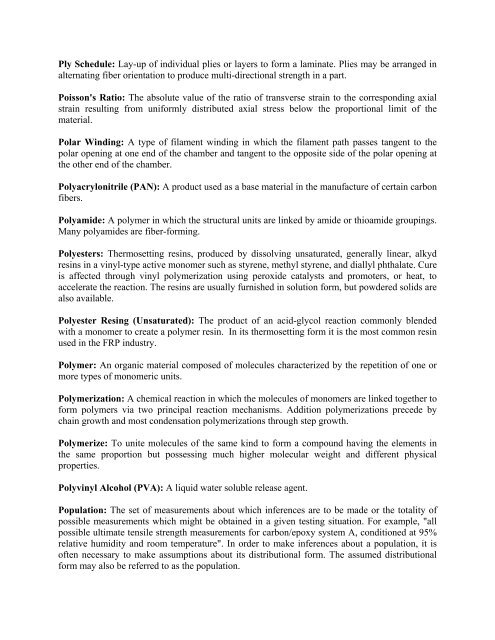Definitions /Dictionary/Glossary - nptel
Definitions /Dictionary/Glossary - nptel
Definitions /Dictionary/Glossary - nptel
Create successful ePaper yourself
Turn your PDF publications into a flip-book with our unique Google optimized e-Paper software.
Ply Schedule: Lay-up of individual plies or layers to form a laminate. Plies may be arranged in<br />
alternating fiber orientation to produce multi-directional strength in a part.<br />
Poisson's Ratio: The absolute value of the ratio of transverse strain to the corresponding axial<br />
strain resulting from uniformly distributed axial stress below the proportional limit of the<br />
material.<br />
Polar Winding: A type of filament winding in which the filament path passes tangent to the<br />
polar opening at one end of the chamber and tangent to the opposite side of the polar opening at<br />
the other end of the chamber.<br />
Polyacrylonitrile (PAN): A product used as a base material in the manufacture of certain carbon<br />
fibers.<br />
Polyamide: A polymer in which the structural units are linked by amide or thioamide groupings.<br />
Many polyamides are fiber-forming.<br />
Polyesters: Thermosetting resins, produced by dissolving unsaturated, generally linear, alkyd<br />
resins in a vinyl-type active monomer such as styrene, methyl styrene, and diallyl phthalate. Cure<br />
is affected through vinyl polymerization using peroxide catalysts and promoters, or heat, to<br />
accelerate the reaction. The resins are usually furnished in solution form, but powdered solids are<br />
also available.<br />
Polyester Resing (Unsaturated): The product of an acid-glycol reaction commonly blended<br />
with a monomer to create a polymer resin. In its thermosetting form it is the most common resin<br />
used in the FRP industry.<br />
Polymer: An organic material composed of molecules characterized by the repetition of one or<br />
more types of monomeric units.<br />
Polymerization: A chemical reaction in which the molecules of monomers are linked together to<br />
form polymers via two principal reaction mechanisms. Addition polymerizations precede by<br />
chain growth and most condensation polymerizations through step growth.<br />
Polymerize: To unite molecules of the same kind to form a compound having the elements in<br />
the same proportion but possessing much higher molecular weight and different physical<br />
properties.<br />
Polyvinyl Alcohol (PVA): A liquid water soluble release agent.<br />
Population: The set of measurements about which inferences are to be made or the totality of<br />
possible measurements which might be obtained in a given testing situation. For example, "all<br />
possible ultimate tensile strength measurements for carbon/epoxy system A, conditioned at 95%<br />
relative humidity and room temperature". In order to make inferences about a population, it is<br />
often necessary to make assumptions about its distributional form. The assumed distributional<br />
form may also be referred to as the population.
















